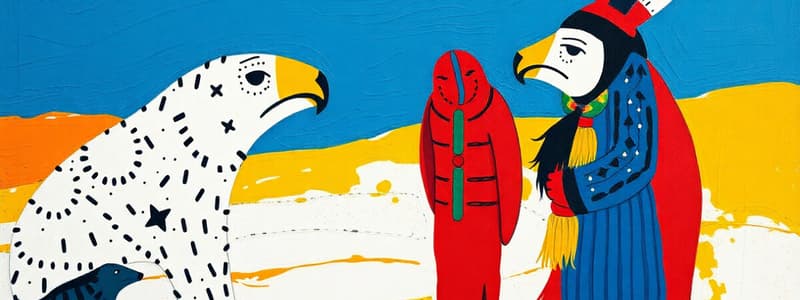Podcast
Questions and Answers
Which of the following best describes the Inuit's relationship with their environment between 1713 and 1800?
Which of the following best describes the Inuit's relationship with their environment between 1713 and 1800?
- They maintained a nomadic lifestyle, following available game and resources seasonally. (correct)
- They disregarded environmental factors and focused solely on family relations.
- They lived in permanent settlements and extracted all possible resources from a local area.
- They attempted to dominate their environment through advanced agricultural techniques.
What was the primary factor influencing the Inuit's nomadic lifestyle between 1713 and 1800?
What was the primary factor influencing the Inuit's nomadic lifestyle between 1713 and 1800?
- Political instability and warfare with neighboring tribes.
- Religious practices that required constant movement.
- Following seasonal migrations of game and availability of resources. (correct)
- A desire to explore and map new territories.
How did the Inuit perceive land ownership and resource management between 1713 and 1800?
How did the Inuit perceive land ownership and resource management between 1713 and 1800?
- Land was divided among the most powerful hunters in the community.
- Individual families held private ownership over specific territories and resources.
- Resources were traded with outsiders for other goods.
- Resources were considered community property, with everyone working together. (correct)
What was the approximate size of a typical Inuit family unit between 1713 and 1800?
What was the approximate size of a typical Inuit family unit between 1713 and 1800?
What principle most guided the Inuit's interactions with each other within their community?
What principle most guided the Inuit's interactions with each other within their community?
What does 'Inuit Nanangat' refer to?
What does 'Inuit Nanangat' refer to?
Which of the following statements best describes the Inuit's approach to conflict resolution between 1713 and 1800?
Which of the following statements best describes the Inuit's approach to conflict resolution between 1713 and 1800?
Which aspect of life was considered most important by the Inuit?
Which aspect of life was considered most important by the Inuit?
What is the name of the Inuit language?
What is the name of the Inuit language?
Considering the Inuit's community-focused culture and nomadic lifestyle, which of the following would be most valued?
Considering the Inuit's community-focused culture and nomadic lifestyle, which of the following would be most valued?
Flashcards
Who are the Inuit?
Who are the Inuit?
Indigenous people living in the Northern Regions of Canada.
What is Inuit Nanangat?
What is Inuit Nanangat?
Inuit Nanangat refers to the land, water, and ice that surrounded the Inuit homeland.
Inuit family size
Inuit family size
Inuit society was structured around small family units, typically consisting of 5 or 6 people.
Inuit lifestyle
Inuit lifestyle
Signup and view all the flashcards
What is Inuktitut?
What is Inuktitut?
Signup and view all the flashcards
Inuit culture
Inuit culture
Signup and view all the flashcards
Study Notes
- The Inuit are Indigenous people inhabiting the Northern Regions of Canada.
- This information pertains to their daily life between 1713-1800.
- Their homeland was known as Inuit Nanangat, referring to the land, water, and ice in their territory.
- They valued peace and considered family of utmost importance.
- Their language is called Inuktitut.
- They were nomadic, moving seasonally to follow game and resources.
- Families typically consisted of 5 or 6 people.
- The Inuit culture was community-focused.
- Food sources were considered community property.
- Community members worked together to support one another.
Studying That Suits You
Use AI to generate personalized quizzes and flashcards to suit your learning preferences.



